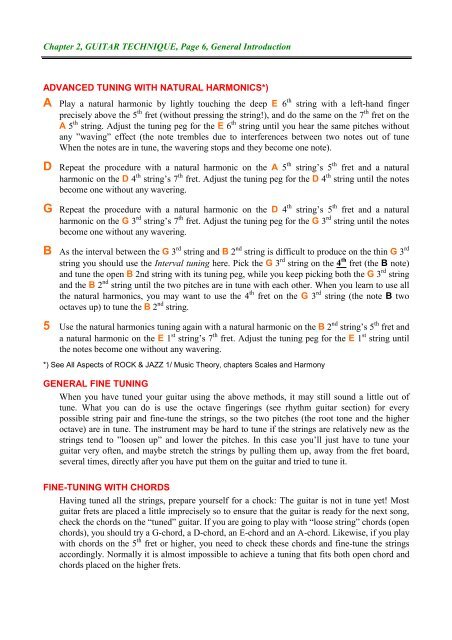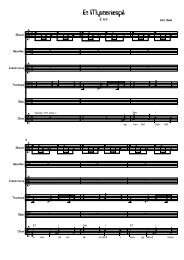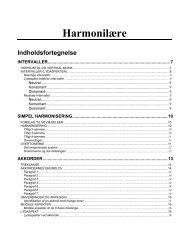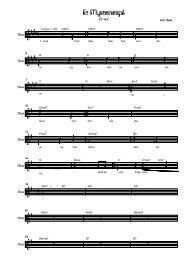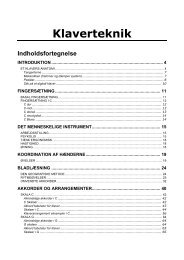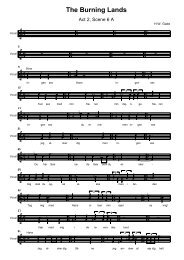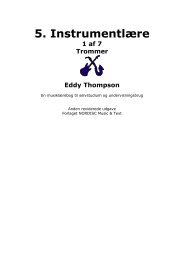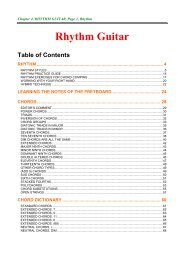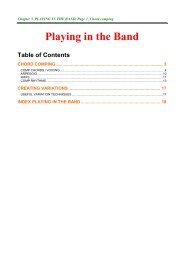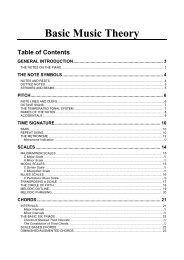Guitar Technique - NORDISC Music & Text
Guitar Technique - NORDISC Music & Text
Guitar Technique - NORDISC Music & Text
Create successful ePaper yourself
Turn your PDF publications into a flip-book with our unique Google optimized e-Paper software.
Chapter 2, GUITAR TECHNIQUE, Page 6, General IntroductionADVANCED TUNING WITH NATURAL HARMONICS*)A Play a natural harmonic by lightly touching the deep E 6 th string with a left-hand fingerprecisely above the 5 th fret (without pressing the string!), and do the same on the 7 th fret on theA 5 th string. Adjust the tuning peg for the E 6 th string until you hear the same pitches withoutany ”waving” effect (the note trembles due to interferences between two notes out of tuneWhen the notes are in tune, the wavering stops and they become one note).D Repeat the procedure with a natural harmonic on the A 5 th string’s 5 th fret and a naturalharmonic on the D 4 th string’s 7 th fret. Adjust the tuning peg for the D 4 th string until the notesbecome one without any wavering.G Repeat the procedure with a natural harmonic on the D 4 th string’s 5 th fret and a naturalharmonic on the G 3 rd string’s 7 th fret. Adjust the tuning peg for the G 3 rd string until the notesbecome one without any wavering.B As the interval between the G 3 rd string and B 2 nd string is difficult to produce on the thin G 3 rdstring you should use the Interval tuning here. Pick the G 3 rd string on the 4 th fret (the B note)and tune the open B 2nd string with its tuning peg, while you keep picking both the G 3 rd stringand the B 2 nd string until the two pitches are in tune with each other. When you learn to use allthe natural harmonics, you may want to use the 4 th fret on the G 3 rd string (the note B twooctaves up) to tune the B 2 nd string.5 Use the natural harmonics tuning again with a natural harmonic on the B 2 nd string’s 5 th fret anda natural harmonic on the E 1 st string’s 7 th fret. Adjust the tuning peg for the E 1 st string untilthe notes become one without any wavering.*) See All Aspects of ROCK & JAZZ 1/ <strong>Music</strong> Theory, chapters Scales and HarmonyGENERAL FINE TUNINGWhen you have tuned your guitar using the above methods, it may still sound a little out oftune. What you can do is use the octave fingerings (see rhythm guitar section) for everypossible string pair and fine-tune the strings, so the two pitches (the root tone and the higheroctave) are in tune. The instrument may be hard to tune if the strings are relatively new as thestrings tend to ”loosen up” and lower the pitches. In this case you’ll just have to tune yourguitar very often, and maybe stretch the strings by pulling them up, away from the fret board,several times, directly after you have put them on the guitar and tried to tune it.FINE-TUNING WITH CHORDSHaving tuned all the strings, prepare yourself for a chock: The guitar is not in tune yet! Mostguitar frets are placed a little imprecisely so to ensure that the guitar is ready for the next song,check the chords on the “tuned” guitar. If you are going to play with “loose string” chords (openchords), you should try a G-chord, a D-chord, an E-chord and an A-chord. Likewise, if you playwith chords on the 5 th fret or higher, you need to check these chords and fine-tune the stringsaccordingly. Normally it is almost impossible to achieve a tuning that fits both open chord andchords placed on the higher frets.


